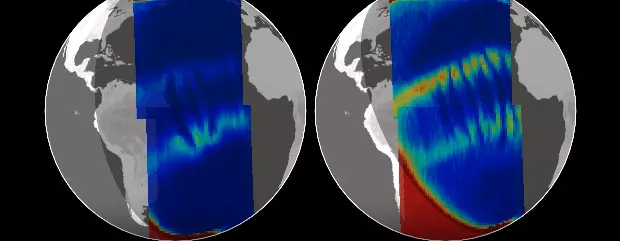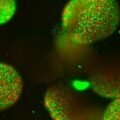NASA’s Global-scale Observations of the Limb and Disk (GOLD) mission has discovered a new phenomenon in the Earth’s upper atmosphere. The mission revealed unexpected X- and C-shaped structures in the ionosphere that have puzzled scientists.
The new findings suggest that our understanding of the ionosphere is far from complete and that more dynamics are at play in this region of Earth’s atmosphere than previously thought.
The ionosphere, a layer of the Earth’s atmosphere extending from about 50 to 400 miles above the surface, is a region where solar radiation ionizes atmospheric particles, creating a plasma of charged particles.
This layer plays a crucial role in long-distance radio communications, as it can reflect radio waves back to Earth. However, GOLD’s new observations have shown formations that challenge current scientific models.
“A unique phenomenon—A geomagnetically quiet time merging of Equatorial Ionization Anomaly (EIA) crests, leading to an X-pattern (EIA-X) around the magnetic equator—has been observed in the night-time ionospheric measurements by the Global-scale Observations of the Limb and Disk mission,” researchers wrote in the study published in the Journal of Geophysical Research: Space Physics.
Observations of these distinctive X-pattern structures had previously been noted only during geomagnetic disturbances, such as after solar storms or volcanic eruptions. However, these new sightings during geomagnetically calm conditions suggest that unknown processes from the lower atmosphere can affect the ionosphere, presenting a new scientific mystery.
Computer simulations showed that these bizarre X-shaped equatorial ionization anomalies are generated during pre-sunset hours and persist until after sunset at local times.
Models also propose that these X-shapes may develop when changes in the lower atmosphere draw plasma downward. However, this hypothesis requires further investigation.
“The X is odd because it implies that there are far more localized driving factors,” Dr. Jeffrey Klenzing, a scientist at NASA’s Goddard Space Flight Center who studies the ionosphere, said in a statement. “This is expected during the extreme events, but seeing it during ‘quiet time’ suggests that the lower atmosphere activity is significantly driving the ionospheric structure.”
Additionally, GOLD identified C-shaped and reverse-C-shaped plasma bubbles near each other. C-shaped plasma bubbles are typically long and straight and form along magnetic field lines. However, on several occasions, GOLD found these structures a mere 400 miles apart, implying that strong turbulence or vortex-like activity in the lower atmosphere influences the ionosphere.
This discovery of closely linked C-shaped bubbles offers further evidence that more complex dynamics are at work in the Earth’s atmosphere than is currently understood.
Dr. Deepak Karan, a research scientist at the University of Colorado’s Laboratory for Atmospheric and Space Physics (LASP) and author of a 2023 study on these mysterious C-shaped bubbles, highlighted the significance of these recent discoveries.
“Within that close proximity, these two opposite-shaped plasma bubbles had never been thought of, never been imaged,” Dr. Karan said. “To have wind patterns change course in such a small area suggests some sort of strong turbulence — like a vortex, wind shear, or tornado-like activity — is likely at play in the atmosphere.”
“The fact that we have very different shapes of bubbles this close together tells us that the dynamics of the atmosphere is more complex than we expected,“ Dr. Klenzing added.
GOLD’s findings are notable for their clarity and consistency, thanks to the satellite’s geostationary orbit, which allows it to continuously monitor the same region of the Earth. This extended observation capability has enabled scientists to detect the persistent nature of these X- and C-shaped structures.
Since its launch in 2018, GOLD has only recorded two instances of C-shaped atmospheric structures being closely paired. Researchers say the bizarre X-shape anomaly has been detected “very clearly on one occasion and to some extent on other six occasions, during geomagnetically quiet periods.“ This suggests that this mysterious phenomenon, which researchers likened to atmospheric “alphabet soup,” is extremely rare.
Nevertheless, these findings are significant as they could impact our understanding of how the ionosphere interacts with communication and navigation signals, which can be disrupted by such plasma structures.
The presence of strong turbulence or localized disturbances in the ionosphere can lead to signal loss or degradation. Our reliance on technologies that depend on stable ionospheric conditions, such as GPS and satellite communications, makes understanding these influences increasingly critical.
Likewise, the mission’s findings underscore the complexity of the Earth’s atmosphere and the need for continued research to understand the various factors that influence its behavior.
NASA says ongoing observations by GOLD, alongside data from other heliophysics missions, are expected to provide more insights into these phenomena. Scientists hope to use this information to shed more light on these enigmatic structures and their implications for our technological world.
Researchers concluded their recent study by noting, “A comprehensive understanding of the dynamics during the pre- to post-sunset period will not only advance our knowledge of the ionosphere’s response to external (lower atmospheric or geomagnetic) drivers but also plays a crucial role in the development of space weather forecasting capability.”
Tim McMillan is a retired law enforcement executive, investigative reporter and co-founder of The Debrief. His writing typically focuses on defense, national security, the Intelligence Community and topics related to psychology. You can follow Tim on Twitter: @LtTimMcMillan. Tim can be reached by email: tim@thedebrief.org or through encrypted email: LtTimMcMillan@protonmail.com

